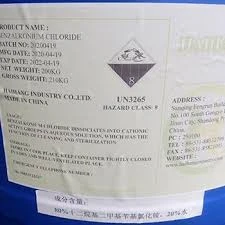isothiazolinone other names
Understanding Isothiazolinones Common Names and Applications
Isothiazolinones are a class of chemical compounds widely used for their excellent biocidal and preservative properties, primarily in industrial and consumer products. These compounds are particularly valued for their effectiveness against bacteria, fungi, and algae, making them essential in various industries, including cosmetics, water treatment, and coatings. In this article, we will explore the various common names of isothiazolinones, their applications, and the considerations surrounding their use.
Common Names of Isothiazolinones
Isothiazolinones include several specific compounds, each with its unique properties and applications. The most recognized members of this class are
1. Methylisothiazolinone (MIT) Often abbreviated as MIT, this compound is commonly used in cosmetic and personal care products, such as lotions, shampoos, and paints. It is especially valued for its ability to prevent microbial growth.
2. Chlormethylisothiazolinone (CMIT) Often found in combination with MIT, CMIT is a potent biocide widely utilized in industrial applications. It is frequently used in paints and adhesives, contributing to their longevity and stability.
3. Octylisothiazolinone (OIT) This variant is often used in industrial water treatment applications, providing protection against microbial contamination in various aqueous systems.
4. Benzisothiazolinone (BIT) An effective biocide, BIT is commonly found in outdoor coatings, sealants, and an array of industrial applications, providing long-lasting protection against a wide range of microorganisms.
Applications of Isothiazolinones
Due to their potent antimicrobial properties, isothiazolinones have a broad spectrum of applications across various industries
isothiazolinone other names

- Cosmetics and Personal Care Products Methylisothiazolinone is frequently employed in lotions, shampoos, and other personal care products due to its ability to prevent microbial contamination, which ensures safety and enhances product longevity. However, it is crucial to note that there are growing concerns regarding its potential skin sensitization.
- Industrial Products Isothiazolinones are integral to many industrial formulations, including paints, adhesives, and coatings. Their effectiveness in preventing microbial growth helps to prolong the shelf life and performance of these products.
- Water Treatment Compounds like octylisothiazolinone are utilized in water treatment facilities to inhibit the growth of algae and bacteria in water systems, ensuring the maintenance of clean and safe water.
- Construction Materials Isothiazolinones are added to construction materials to prevent microbial growth, thus improving the durability and safety of products such as sealants and paints.
Safety and Regulatory Considerations
While isothiazolinones are effective biocides, their use has raised safety concerns, particularly regarding skin sensitization and allergic reactions. The cosmetic and personal care industries have seen heightened scrutiny concerning the presence of MIT and CMIT in their formulations. Regulatory agencies in various countries have issued guidelines to limit their concentration in consumer products, emphasizing the need for manufacturers to conduct thorough safety assessments.
In response to these concerns, many companies are reformulating their products to reduce or eliminate the use of isothiazolinones. Alternative preservatives, such as natural extracts and other synthetic compounds, are being explored to maintain product safety without compromising quality.
Conclusion
Isothiazolinones, including methylisothiazolinone, chlormethylisothiazolinone, octylisothiazolinone, and benzisothiazolinone, play a crucial role in preventing microbial growth in various industrial and consumer products. Their effectiveness as biocides has made them invaluable in applications ranging from cosmetics to water treatment. However, growing concerns about safety and potential allergic reactions necessitate careful consideration and regulatory oversight. As the industry evolves, we can expect to see ongoing innovation in the search for safer alternatives to these compounds while maintaining the high standards of product effectiveness that consumers and businesses expect.
-
Water Treatment with Flocculant Water TreatmentNewsJun.12,2025
-
Polymaleic AnhydrideNewsJun.12,2025
-
Polyaspartic AcidNewsJun.12,2025
-
Enhance Industrial Processes with IsothiazolinonesNewsJun.12,2025
-
Enhance Industrial Processes with PBTCA SolutionsNewsJun.12,2025
-
Dodecyldimethylbenzylammonium Chloride SolutionsNewsJun.12,2025





